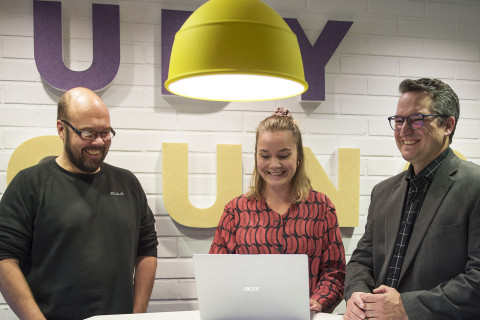The University of Eastern Finland was among the first higher education institutions to start implementing the flipped classroom (FC) model in 2015 in several fields taught at the university. According to a research paper published in summer 2019, after participating in a flipped classroom course, students found that teachers who use the FC model have better pedagogical, specialist and technological skills.
Based on the results of a student survey, especially second-year and higher students perceive teachers using the FC model as having better knowledge of pedagogy and technology in teaching their subject. The results were published on Seminar.net, the International Journal of Media, Technology and Lifelong Learning. The article was written by Team Ameba, a multidisciplinary research team focusing on the development of learning environments formed at the University of Eastern Finland. The work of Team Ameba has already received both national and international recognition.
Based on the results of the study, approximately 88 per cent of students found the flipped classroom approach suitable for them, and approximately 78 per cent were willing to participate in flipped classroom courses in the future. On the other hand, roughly 30 per cent of the respondents wanted their courses to be implemented with the traditional model rather than the FC model.
The flipped classroom model meets future learning needs
Teachers at the University of Eastern Finland were trained to implement the flipped classroom (or flipped learning) model in teaching and received systematic support for implementing the FC model in 2016–2018. The aim was to change the university’s teaching and learning culture towards teaching that supports a learning-centred approach and uses technology in a more meaningful way.
“In the flipped classroom model, traditional lecturing is replaced by the use of information and communication technology (ICT), such as viewing short video clips before the class. This way, students come to the classroom prepared and the teacher can implement a learning-centred approach in their teaching,” says Assistant Professor Erkko Sointu, who is a member of Team Ameba.
To implement the FC model, teachers need to change their way of thinking and method of organising courses.
“The students also need to internalise the new model, which means that the teacher has to spend of lot of time guiding them. Such a huge change should be based on a holistic strategic aim, which is exactly the approach that has been adopted at the University of Eastern Finland.”
Associate Professor Teemu Valtonen says that the flipped classroom model provides a way of transitioning from traditional lecturing towards new teaching methods.
“Flipped classroom courses seem to be successful because they have certain familiar elements but also some new elements, which have been added there for a reason, helping to achieve the skill sets needed in the future more effective than traditional methods.”
Further information:
Erkko Sointu, Assistant Professor, erkko.sointu(at)uef.fi, tel. +358 50 560 4461
Teemu Valtonen, teemu.valtonen(at)uef.fi, Associate Professor, tel. +358 50 442 4401
http://www.uef.fi/en/web/ameba
http://www.uef.fi/fi/web/flippaus
Original article: Teachers as users of ICT from the student perspective in higher education flipped classroom classes
International Journal of Media, Technology and Lifelong Learning, julkaistu 14.6.2019, https://journals.hioa.no/index.php/seminar/article/view/3402
Erkko Sointu, Teemu Valtonen, Laura Hirsto, Jenni Kankaanpää, Markku Saarelainen, Kati Mäkitalo, Anneke Smits & Jyri Manninen
